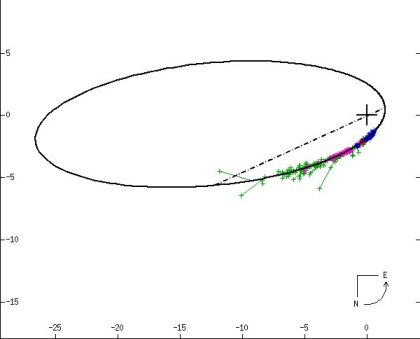
 |
From two centuries of data, the motion of 53 Aquarii B is plotted around 53 Aqr A as if the latter were at the orbital focus and stationary. The scale is in seconds of arc and the dot-dash line is the orbital major axis. A tilt of 44 degrees distorts the orbital path from what it would look like were it face-on. In reality, both stars go around a common center of mass almost exactly between them. Over a period of 3500 years, the highly elliptical path takes the stars from as far as 575 AU apart to as close as 30. They will be closest (at the short end of the major axis) in 2023. From the average separation of 300 AU and the period we find the sum of the stellar masses to be 2.25 times that of the Sun, or 1.13 solar masses for each, close to that derived from theory. (W. I. Hartkopf and B. D. Mason, Sixth Catalog of Orbits of Visual Binary Stars, US Naval Observatory Double Star Catalog, 2006.) |